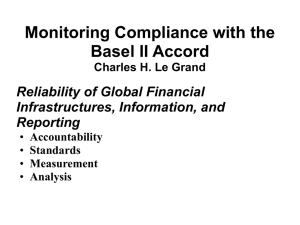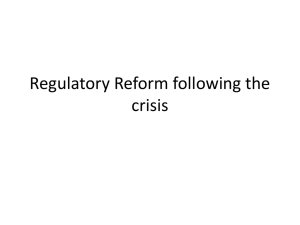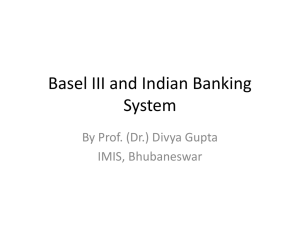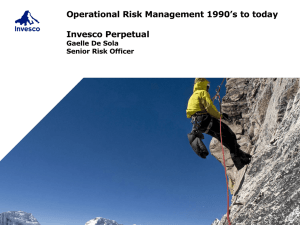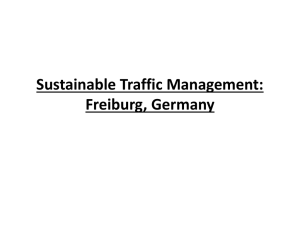Risk Management and Implementation of Pillar 2 in the Middle East
advertisement
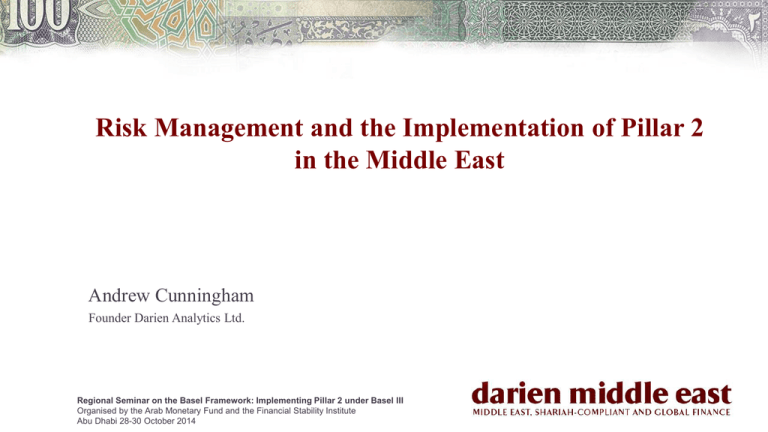
Risk Management and the Implementation of Pillar 2 in the Middle East Andrew Cunningham Founder Darien Analytics Ltd. Regional Seminar on the Basel Framework: Implementing Pillar 2 under Basel III Organised by the Arab Monetary Fund and the Financial Stability Institute Abu Dhabi 28-30 October 2014 Middle Eastern banks have strong BIS capital ratios BIS Capital Ratios of Middle Eastern Banks, end-2013 (Source: The Banker magazine) 40 35 Number of banks 35 30 30 25 17 20 15 10 5 0 2 0 < 8% 2 8 - 11.9% 12 - 15.9% BIS Capital Ratio % Regional Seminar on the Basel Framework: Implementing Pillar 2 under Basel III Organised by the Arab Monetary Fund and the Financial Stability Institute Abu Dhabi 28-30 October 2014 16 - 19.9% 20% or more Reasons for GCC banks declaring net losses, 2011-2013 Net loss in 2013 Net loss in 2012 Bank A Net loss in 2011 Memo: un-weighted equity/asset ratio (year of loss) Provisions against NPLs 14.9% Bank B High operating expenses and provisions against NPLs Bank C Provisions against NPLs and fair value adjustment of investments Provisions against NPLS 8.4% (2012), 12.1% (2011) High operating expenses and provisions against NPLs High operating expenses and provisions against NPLs 7.2% (2013), 8.2% (2012), 8.4% (2011) 11.9% Bank D High operating expenses and very large provisions against NPLs Bank E Provisions against NPLS and write down of value of investments Bank F High operating expenses Bank G Costs of bank start-up 97% Bank H Costs of bank start-up 71% 18.4% High operating expenses and large provisions against NPLs Bank I High operating expenses Losses on investment in property 22.3% (2013). 42.8% (2012), 80% (2011) 22.3% These are real banks, but they are referred to as “Bank A”, “Bank B” etc to give them anonymity. Source for data: Darien Analytics GCC Commercial Bank Performance Rankings 2014 3 Regional Seminar on the Basel Framework: Implementing Pillar 2 under Basel III Organised by the Arab Monetary Fund and the Financial Stability Institute Abu Dhabi 28-30 October 2014 Pillar 1 – minimum capital ratio – is not a powerful prudential tool in the Middle East • Banks show strong risk-adjusted capital ratios (often due to to a significant proportion of their assets being invested in local-currency bonds issued by their own governments)… • And their un-weighted capital ratios (equity/total assets) are also strong. • Most banks are not under pressure from shareholders/market analysts to maximise the efficiency of their capital. 4 Regional Seminar on the Basel Framework: Implementing Pillar 2 under Basel III Organised by the Arab Monetary Fund and the Financial Stability Institute Abu Dhabi 28-30 October 2014 Regulatory Process for Strong Capital Adequacy Minimum Capital Ratio Pillar 1 ICAAP Pillar 2 SREP Pillar 2 Strong long-term capital adequacy Internal Capital Adequacy Assessment Process (ICAAP): the bank assesses the amount of capital that it requires, taking account of its strategy and the risks it faces. Supervisory Review and Evaluation Process (SREP): the supervisor reviews and challenges the bank’s ICAAP. 5 Regional Seminar on the Basel Framework: Implementing Pillar 2 under Basel III Organised by the Arab Monetary Fund and the Financial Stability Institute Abu Dhabi 28-30 October 2014 Implementation of Pillar 2 (from Basel 2 and Basel 2.5) (FSI Survey, Basel 2, 2.5 and 3 Implementation. July 2014) Implementation of Pillar 2 (Basel 2) Implementation of Supplemental Pillar 2 Guidance (Basel 2.5) Bahrain 1 1 Egypt 2 2 Jordan 4 1 Kuwait 4 1 Lebanon 4 4 Morocco 4 4 Oman 4 1 Qatar 4 4 Tunisia 1 -- UAE 4 2 Note: 1 = Draft regulation not published; 2 = Draft regulation published; 3 = Final Rule Published; 4 = Final rule in force. 6 Regional Seminar on the Basel Framework: Implementing Pillar 2 under Basel III Organised by the Arab Monetary Fund and the Financial Stability Institute Abu Dhabi 28-30 October 2014 Pillar 2 implementation in the Middle East has focused on stress tests/ICAAP rather than SREP 7 • Many Central Banks in the Middle East have required banks to conduct stress tests in relation to their capital levels. • Many Central Banks in the Middle East have required banks to conduct ICAAPs and have published guidance on what ICAAPs should include. • Central Banks have said little about their plans to conduct SREPs or how they would conduct them. Regional Seminar on the Basel Framework: Implementing Pillar 2 under Basel III Organised by the Arab Monetary Fund and the Financial Stability Institute Abu Dhabi 28-30 October 2014 Identifying areas of focus for Pillar 2/SREP discussions: Stage 1 Major bank risks in your country 8 Regional Seminar on the Basel Framework: Implementing Pillar 2 under Basel III Organised by the Arab Monetary Fund and the Financial Stability Institute Abu Dhabi 28-30 October 2014 Identifying areas of focus for Pillar 2/SREP discussions: Stage 2 Major bank risks in your country 9 Areas of focus Regional Seminar on the Basel Framework: Implementing Pillar 2 under Basel III Organised by the Arab Monetary Fund and the Financial Stability Institute Abu Dhabi 28-30 October 2014 Risks that are not captured in Pillar 1 Identifying areas of focus for Pillar 2/SREP discussions: Stage 3 Risk areas identified by Basel Areas of focus 10 Major bank risks in your country Regional Seminar on the Basel Framework: Implementing Pillar 2 under Basel III Organised by the Arab Monetary Fund and the Financial Stability Institute Abu Dhabi 28-30 October 2014 Risks that are not captured by Pillar 1 Identifying areas of focus for Pillar 2/SREP discussions: Stage 4 Risk areas identified by Basel Areas of focus Major bank risks in your country Macro prudential risks in your country Risks that are not captured by Pillar 1 11 Regional Seminar on the Basel Framework: Implementing Pillar 2 under Basel III Organised by the Arab Monetary Fund and the Financial Stability Institute Abu Dhabi 28-30 October 2014 Possible areas of focus for Middle East SREPs Major bank risks in your own country For example: •This list to be based on objective review of the causes of actual bank losses in your country Risks that are not captured by Pillar 1 For example: • Interest rate risk in the banking book (IRRBB) • Concentration risk (large exposure to single counterparties/sectors/countries, etc) • Reputational risk 12 Regional Seminar on the Basel Framework: Implementing Pillar 2 under Basel III Organised by the Arab Monetary Fund and the Financial Stability Institute Abu Dhabi 28-30 October 2014 Risk Areas Identified by the Basel For example: • Governance and Risk Management • Off balance sheet exposures/securitisation • Risk concentrations • Regulatory incentives for better risk management • Pay and incentives • Stress testing • Accounting standards • Governance • Supervisory colleges Macro prudential risks in your country For example: • Real Estate Risk (particularly in the GCC) • Political Risk • Loss of IT systems/basic functions (in some countries) • Mortgage finance (some countries) Key risk areas for Pillar 2 review in the Middle East 1. Governance and risk awareness among Board Members 2. Strategic Positioning: is the bank’s strategy viable for the long term? 3. Concentration risk, including large exposures to domestic government agencies 4. Exposure to financial instruments whose Fair Value is Carried through the profit and loss account (FVTPL) 5. Stress-tested quality of loans 6. Compliance with international standards on money-laundering/financial crime/combatting the financing of terrorism (CFT) 13 Regional Seminar on the Basel Framework: Implementing Pillar 2 under Basel III Organised by the Arab Monetary Fund and the Financial Stability Institute Abu Dhabi 28-30 October 2014 Implementation Challenges: the Supervisors’ Perspective 1. Resources: both on-site and off-site supervision will be more intense 2. Resources: supervisory staff will need to upgrade their technical knowledge 3. Resources: senior supervisory staff will need to be more heavily involved in on-site supervision 4. Many major risks will continue to be “external” to the banking sector (e.g. political risk; commodity price risk) 5. Lack of urgency because international scrutiny of Middle East banks (e.g. from brokers, investors) still lags the scrutiny given to international banks 14 Regional Seminar on the Basel Framework: Implementing Pillar 2 under Basel III Organised by the Arab Monetary Fund and the Financial Stability Institute Abu Dhabi 28-30 October 2014 How would strong Pillar 2 implementation affect Middle East banks? 1. More bank mergers and acquisitions as weaker banks are forced to close or given incentives to close 2. Development of debt capital markets as banks reduce concentration of credit to government agencies and central banks 3. More difficult relationship between bank supervisors and Board members as on-site supervision becomes tougher 4. Banks’ management more internally focussed (responding to supervisory demands) with less time for overseas adventures. 15 Regional Seminar on the Basel Framework: Implementing Pillar 2 under Basel III Organised by the Arab Monetary Fund and the Financial Stability Institute Abu Dhabi 28-30 October 2014 Final Thought When Supervisors ask Middle Eastern banks about their risk profiles, the quality of the answer may be more important than the answer itself. 16 Regional Seminar on the Basel Framework: Implementing Pillar 2 under Basel III Organised by the Arab Monetary Fund and the Financial Stability Institute Abu Dhabi 28-30 October 2014 Important Documents about Pillar 2 and Supervisory Review Enhancements to the Basel II Framework Basel Committee on Banking Supervision. July 2009. 35 pages Guidance on Supervisory Interaction with Financial Institutions on Risk Culture Financial Stability Board, April 2014. 10 pages (Focus is on SIFIs but useful when considering non-SIFIs) Supervisory Intensity and Effectiveness Financial Stability Board, April 2014.15 pages (Focus is on SIFI’s but useful when considering non-SIFIs) Core Principles for Effective Banking Supervision Basel Committee on Banking Supervision. Updated September 2012. 85 pages 17 Regional Seminar on the Basel Framework: Implementing Pillar 2 under Basel III Organised by the Arab Monetary Fund and the Financial Stability Institute Abu Dhabi 28-30 October 2014
